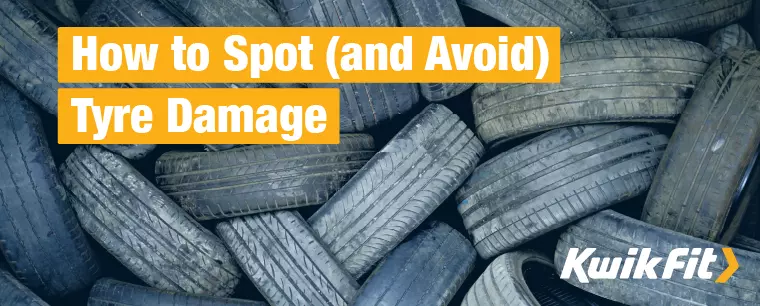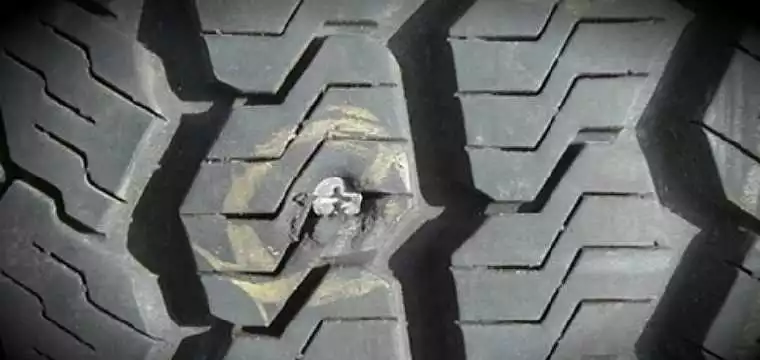How to Spot (and Avoid) Tyre Damage
Jack Dreyer | Monday 19th June 2023 12:00pm

Modern life can be busy and many drivers donít think about whether their tyres might be damaged. Often, tyre damage can go unnoticed. However, excessive tyre damage can put you in a dangerous situation when driving. Tyres keep your vehicle in contact with the road, so any damage that has occurred can cause serious issues. Continue reading to find out more about the red flags you should be regularly looking out for.
Tyre cuts
Cuts on your tyres can be caused by poor road surfaces, potholes, debris, and more ó and they often occur on the tyreís sidewall. In unlucky situations, tyre cuts can instantly cause tyre failure. However, this isnít usually the case. If you do discover any cuts on your tyres, you should get the tyre examined by a professional.
Tyre bulges
These usually occur as a result of your tyre impacting heavily on a solid object like a kerb or pothole. In turn, the internal air pressure causes a bulge where the rubber of the sidewall has weakened.
Bulging might not be noticeable right away ó and you might only spot it later on. If you do spot a bulge, take great care; this area is now a weak spot on your tyre and will need professional checking as soon as possible.
How to avoid tyre sidewall damage
While itís not possible to avoid sidewall damage altogether, there are some key tips for helping reduce the likelihood:
- Avoid contact with kerbs. It may sound obvious, but youíd be surprised how many drivers regularly hit the kerb Ė especially when attempting to park. Scrapes and bumps will increase the chances of tyre sidewall damage.
- Avoid driving into potholes. With so many potholes on the UKís roads, itís understandable if this seems impossible, but managing to do so will greatly reduce your chances of sidewall damage. Reduce your speed on country roads so you can safely drive around them.
- Maintain the correct tyre pressures. Your sidewalls will be exposed to unwanted additional forces and pressures if your tyres arenít correctly inflated. The right tyre pressures will help to reduce the chance of sidewall damage.
- Clean off any spilled oil you find on your tyres. Why? Because solvents and oils Ė including those in dirty water Ė will negatively soften your tyreís compound and, ultimately, result in sidewall damage. Clean them off as soon as possible with water and washing up liquid.

Example of a cut and bulge in sidewall
Irregular tyre wear
Tyre wear occurs naturally. The speed that your tyres wear down is due to your driving style and how often you drive. Tyre treads under 1.6mm are below the legal limit and need to be changed. Without good tyre treads youíll not only struggle to brake but also accelerate and steer.
Itís also worth keeping in mind that youíre not necessarily in the Ďsafe zoneí just because your tyre treads are over 1.6mm. Even tyres under 3mm can wear down rapidly and lose grip.
Unfortunately, because so many drivers do not carry out regular tyre checks, treads become too worn down and become dangerous. But itís not just regular wear with time that you need to look out for.
If your tyres are over or under inflated, they can be subjected to irregular wear, which may mean that your tyre needs to be replaced sooner than usually necessary. Over-inflated tyres will wear down more in the centre. As a result, the contact patch between the tyre and the road is reduced. Under-inflated tyres also cause uneven wear, but in this case to the edges of the tyre.
Itís not only under and over-inflation that can cause excessive tyre wear, but also an issue with wheel alignment. Potholes, collisions, and faulty shocks may be to blame if this is the case!

Punctures
A puncture is one of the most common types of tyre damage. When sharp objects from the roadís surface pierce the tyre, air leaks out Ė slowly or quickly, depending on the severity.
As you might imagine, the clearest sign of a puncture is a deflated tyre! But it can be much more subtle than that. If youíre finding, for example, that your tyre needs air every week, itís highly likely that youíve got a slow puncture. Oftentimes, these wonít be visible to the untrained eye.
Some tyres, such as Continentalís ContiSealô, use modern technology to ensure punctures up to 5mm are sealed, giving you extended mileage so you can safely reach a garage. Other tyres, like Continentalís self-supporting run flats, allow the driver to continue driving for up to 50 miles (at a maximum speed of 50mph).

How to avoid a puncture
- Check for foreign objects on a regular basis. If your mindset is to regularly check your tyres to ensure the pressures are correct, and that the treads are UK road legal, youíll also be able to spot tyre damage from sharp objects. You donít want a tyre blowout.
- Remove embedded objects as soon as possible before they cause further damage. Pliers will usually do the job. Youíll need to keep an eye out for any subsequent deterioration, and if youíre unsure whether to keep driving on the tyre(s), seek professional advice from your local Kwik Fit centre. Likewise, if you think the object may have pierced the tyre, itís best to leave the object in place and head to your local Kwik Fit as soon as possible Ė you can always change to a spare tyre, of course, but itís more hassle to change to the spare wheel yourself if you suspect a slow puncture.
- Consider self-sealing or run-flat tyres, like those fitted with Continentalís ContiSealô technology. They reduce the risk of a flat tyre, are available across a wide range of their products, and can be purchased at and fitted by Kwik Fit.
Concerned about your tyres?
Of course, tyres wear down through normal usage over time. But if thereís an obvious issue with your tyre or you have a concern about something more subtle, itís worth getting it checked.
If you have any concerns about your tyres, book a free vehicle safety check at your local Kwik Fit and our team will be happy to help.
Any facts, figures and prices shown in our blog articles are correct at time of publication.
Featured Articles
Is it Illegal to Drive With One Headlight?
Saturday 19th July 2025
Wondering if itís illegal to drive with one headlight? Learn about the safety risks and penalties of illegal blown bulbs and why you should fix them promptly.
Air Con in EVs & Hybrids: Experts Answer Your Questions
Monday 30th June 2025
Does air con drain EV batteries? Can you use the air con while charging an electric car? Find out the answers to these questions & more from Kwik Fitís experts.
Why Is Your Car Making a Noise? Fixes & Tips
Friday 13th June 2025
When your car starts making unexpected noises, it can certainly be quite disconcerting; it may be nothing to worry about, but hereís what you need to know.









